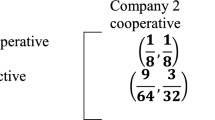Abstract
This paper applies stochastic evolutionary game theory to analyzing the stability of cooperation among members against external opportunism in a multi-firm alliance. The authors first review the pros and cons of pertinent traditional models, and then a stochastic game model on decisions is proposed, where a coordination parameter, a time variable, a punishment effect and bounded rationality are considered. The Gauss white noise is introduced to reflect the random disturbance in the process. Several sufficient criteria on stability are developed, which enable us to investigate “if-then”type scenarios and project the impact of different strategies.
Similar content being viewed by others
References
Zaheer A and Bell G G, Benefiting from network position: Firm capabilities, structural holes, and performance, Strategic Management Journal, 2005, 26(9): 809–825.
Nagarajan M and Sosic G, Game-theoretic analysis of cooperation among supply chain agents: Review and extensions, European Journal of Operational Research, 2008, 187(3): 719–745.
Van A M, The state of network organization: A survey in three frameworks, Journal of Organizational Computing, 1997, 73: 165–176.
Das T K and Teng B S, Instabilities of strategic alliances: An internal tensions perspective, Organization Science, 2000, 11(1): 77–101.
Das T K and Teng B S, Strategic risk behavior and its temporalities: Between propensity and decision context, Journal of Management Studies, 2001, 38(4): 4–12.
Parkhe A, Strategic alliance structuring: A game theory and transaction cost examination of inter-firm cooperation, Academy of Management Journal, 1993, 36: 794–829.
Rao B P and Reddy S K, A dynamic approach to the analysis of strategic alliances, International Business Review, 1995, 4(4): 499–518.
Aloysius J A, Research joint ventures: A cooperative game for competitors, European Journal of Operational Research, 2002, 136(3): 591–602.
Macneil I R, The New Social Contract, Yale University, New Haven, 1980.
Williamson O E, The Economic Institutions of Capitalism, Free Press, New York, 1985.
Dollinger M J, Golden P A, and Saxton T, The effect of reputation on the decision to joint venture, Strategic Management Journal, 1997, 18(2): 127–140.
Hill C W, Cooperation, opportunism, and the invisible hand: Implications for transaction cost theory, Academy Management Review, 1990, 15(3): 500–513.
Saxton T, The effects of partner and relationship characteristics on alliance outcomes, Academy Management Journal, 1997, 40(2): 443–461.
Inkpen A C and Beamish P W, Knowledge, bargaining power, and the instability of international joint ventures, Academy of Management Review, 1997, 22(1): 177–202.
Zeng M and Chen X P, Achieving cooperation in multiparty alliances: A social dilemma approach to partnership management, Academic Management Review, 2003, 28(4): 587–605.
ALgarwal R, Croson R, and Mahoney J T, The role of incentives and communication in strategic alliances: An experimental investigation, Strategic Management Journal, 2010, 31(4): 413–437.
Kollock P, Social dilemmas: The anatomy of cooperation, Annual Review of Sociology, 1998, 24: 183–214.
Axelrod R, The Evolution of Cooperation, Basic Books, New York, 1984.
Oye K A, Cooperation Under Anarchy, Princeton University, Princeton, 1986.
Bleeke J and Ernst D, Collaborating to compete: Using strategic alliances and acquisitions in the global marketplace, Wiley, New York, 1993.
Webster’ s New Collegiate Dictionary, Combined Action or Operation, as of Muscles, Nerves, ect., Merrian Company, Springfield, Mass, 1961.
Cai G S and Kock N, An evolutionary game theoretic perspective on e-collaboration: The collaboration effort and media relativeness, European Journal of Operational Research, 2009, 194(3): 821–833.
Kock N, The psychobiological model: Toward a new theory of computer mediated communication based on darwinian evolution, Organization Science, 2004, 15(3): 327–348.
Ohtsuki H, Stochastic evolutionary dynamics of bimatrix games, Journal of Theoretical Biology, 2010, 264(1): 136–142.
Celentani M and Ganuza J J, Corruption and competition in procurement, European Economic Review, 2002, 46(7): 1273–1303.
Xavier M P, Longer lives, fertility, and accumulation, Economic Letters, 2003, 80(2): 175–180.
Amanna E and Possajennikov A, On the stability of evolutionary dynamics in games with incomplete information, Mathematical Social Sciences, 2009, 58(3): 310–321.
Honerkamp J, Stochastic Dynamical Systems, VCH Publishers, New York, 1994.
ItÔ K, On stochastic differential equations, Member of American Mathematical Society, 1951, 4: 1–51.
Mao X, Expontetial Stability of Stochastic Differential Equations, Marcel Dekker Inc, New York, 1994.
Yan A and Zeng M, International joint venture instability: A critique of previous research, a reconceptualization, and directions for future research, Journal of International Business Studies, 1999, 30(2): 397–414.
Gill J and Butler R J, Managing instability in cross-cultural alliances, Long Range Planning, 2003, 36(6): 543–563.
Jiang X, Li Y, and Gao S X, The stability of strategic alliances: Characteristics, factors and stages, Journal of International Management, 2008, 14(2): 173–189.
Author information
Authors and Affiliations
Corresponding author
Additional information
This research was supported by the Scientific Research Foundation of Shandong Province in 2014, the OutstandingYoung Scientist Award under Grant No. BS2014SF009, the National Natural Science Research ofChina under Grant Nos. 71373194, 71101059, 71172086, 71272122, 61304175, and the Ministry of Education ofHumanities and Social Science Youth Fund Project under Grant No. 13YJC630013.
This paper was recommended for publication by Editor ZOU Guohua.
Rights and permissions
About this article
Cite this article
Xu, Y., Yu, B., Wang, Y. et al. A stochastic evolutionary game perspective on the stability of strategic alliances against external opportunism. J Syst Sci Complex 28, 978–996 (2015). https://doi.org/10.1007/s11424-015-2104-x
Received:
Revised:
Published:
Issue Date:
DOI: https://doi.org/10.1007/s11424-015-2104-x




